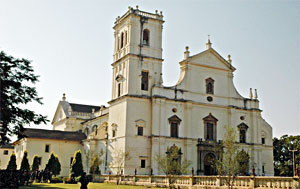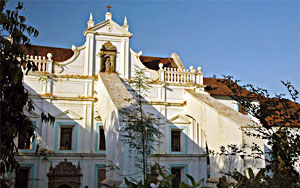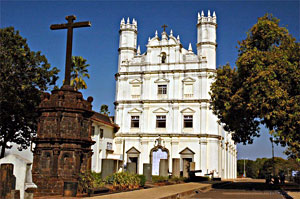|
|
Goa Churches
..........................................................................................................................
|
|
The churches are the most visited landmarks
in Goa. The churches reveals the rich and religious heritage
of Goa and are monuments in stone. They are of great interest
to the historians, archaeologists, students of art and
architecture, tourists and intellects. The churches of Old Goa,
built in the 16th and 17th centuries, are built in the baroque
Renaissance style with some Gothic touches. But its inside is
derived from European and Indian elements. The “Church of Old
Goa” has also received recognition by UNESCO as a World
Heritage Site. It is a popular tourist attraction in Goa. Some
famous churches in Goa are the Basilica of Bom Jesus, Se
Cathedral, Chapel of St. Xavier, St. Monica Church, St.
Francis Church and St. Augustine Church. |
|
|
|
Basilica of Bom Jesus
The Basilica of Bom Jesus is dedicated to infant (Bom)
Jesus Christ. The Basilica of Bom Jesus is famous
throughout the Roman Catholic world. This church houses
the Holy sacrament and the body of St. Francis Xavier.
In this church, the embalmed body of Goa’s patron saint,
St. Francis Xavier is kept in the perfectly preserved
state since his death, almost 450 years ago. The
construction of the church was started in 1594 and
completed in 1605. Its richly gilded main alter has the
figure of infant Jesus. Up above, there is a big statue
of St. Lgnatium of Loyola, the founder of the order of
Jesuit. The Holy Trinity of the father, the son and the
Holy Ghost are depicted on a medallion.
The Chapel of St.
Xavier
The Chapel of St. Xavier belongs to the Doric oder
|
 |
|
|
architecturally. The Chapel was located within the College of
St. Paul and was dedicated either to St. Anthony or to St.
Jerome. As the Chapel was used by St. Francis Xavier, it was
re-dedicated to him after his canonization in 1622. The
original Chapel fell into ruins in 1570 and the present Chapel
was rebuilt in 1884.
Church of St. Alex
The Church of St. Alex, with its two towers, ornated altars
and a magnificent dome displays the beauty of the
architectural style.
Ries Magos Church
The Ries Magos Church is also known as the Church of the Three
Magi King. This church was built in 1555. Once this church was
the mission center of the Franciscan Order of Monks and later
it became the official residence of the Portuguese
dignitaries.
Church of St. Andrew
The Church of St. Andrew is situated at the northern end of
Velha Goa. In this church, a fortnight before Easter, 30
status of the saints were stolen. Later, these were paraded
around the roads of the village. |
|
|
|
Se
Cathedral
Se Cathedral is the largest church in Goa, India and
Asia. The original building was built of mud, stones and
straw in 1510 and was dedicated to St. Catherine, as on
25th Nov, the St. Catherine’s day, Alfonso de
Albuquerque conquered Goa. The Portuguese viceroy, Dam
Francisco Coutinho, the Count of Redondo commissioned
its construction. The construction was started in 1562
and completed in 1652. The Dam |
 |
|
|
Francisco
Coutinho wanted this church to be a grand church worthy of
wealth, power and fame of the Portuguese who dominated the
seas from the Atlantic to the Pacific. Se Cathedral has 14
altars, a 80 meter long aisle and 5 bells. Out of these 5
bells, one of the bell is the famous ”Golden bell”. The aisle,
with its ornamental embellishments culminates in a magnificent
gilt alter.
The Chapel of Our Lady of The Mount
The Chapel of Our Lady of The Mount is situated on an
elevation. This Chapel is built of laterite and plastered with
lime mortar. It has three main altars which are dedicated to
Our Lady of the Mount, St. Anthony and St. Andrew. This Chapel
was built under the orders of Afonso de Albuquerque in 1510.
Church of Our Lady of the Rosary
The Church of Our Lady of the Rosary was built by Alfonso de
Albuquerque. Its façade has the appearance of a fortress. In
front of its altar lies the tombstone of Garcia de Sa, one of
the early governors of Goa and his wife Caterina a Piro, the
first Portuguese woman to arrive in Goa. This church is a fine
example of “Manueline” style of architecture of the early
Portuguese. Its interior is simple and has five altars. The
main altar bears the image of Nossa Senhora de Rozario or Our
Lady of the Rosary. |
|
|
|
Church and
Convent Of St. Monica |
|
The
Convent of St. Monica was sanctioned in 1598 and its
foundation was laid on 2nd July, 1606 by the Arch bishop
Dom Frei Alexio de Menezes who was also the Governor of
Portuguese India. Its work was completed in 1627. It is
a huge three storied building of laterite with a large
inner courtyard. The halls are painted with floral
decorations and scenes from the Holy Bible. The convent
was later known as the Royal Monastery of Santa Monica.
It was also the first |
 |
|
|
nunnery of the East.
St. Cajetan Church
The St. Cajetan Church was built by Italian friars of the
order of Theatines in 1640. The friars were missionaries
appointed by the Pope Urban VIII to preach Christianity to the
Kingdom of Golconda. The church is dedicated to our Lady of
Divine Providence but is popularly known as the St. Cajetan
Church after the founder of the order of Theatines. The St.
Cajetan Church has been modeled after the Basilica of St.
Peter’s in Rome. Its length is about 121 feet and breadth is
about 81 feet. It is built of laterite stone and lime
plastered. The external architecture is Corinthian and the
interior is mosaic – Corinthian style of architecture.
Chapel of St. Anthony
The Chapel Of St. Anthony is dedicated to St. Anthony, the
patron saint of the Portuguese army and navy. This Chapel is
also one of the earliest Chapel to be built in Goa by Alfonso
de Albuquerque. It was destroyed in 1835 and rebuilt in 1961
by the last Governor General of Goa, Vassalo de Silva.
Rachol Seminary
Rachol Seminary is located about 12 kms from Margoa in south
of Goa. In 1521 the Portuguese, in their customary fashion
first built a church and then a prison, and later in 1574 a
seminary to impart philosophy and theology. The museum of
Christian art is housed in this Seminary. |
|
|
|
Church of St. Francis of Assisi
|
|
The Church of St. Francis was built by eight Franciscan
Friars who, constructed a small Chapel after their
arrival in 1517, featuring three altars and a choir.
This Chapel was destroyed in 1661 and the present church
was rebuilt retaining its exquisitely carved old gate
made of black stone. The church has a courtyard and an
old large cross made of black stone. Its external
architecture belongs to the Tuscan |
 |
|
|
order and its
interior belongs to the mosaic Corinthian style. Its length is
about 190 feet and breadth is about 60 feet.
Convent
and Church of St. Augustine
The Convent of St. Augustine is now completely in ruins. This
convent was constructed by 12 Augustinian Fraiars in 1572
immediately after their arrival in Goa on 3rd September 1572.
It was reportedly in good shape until it was abandoned in 1853
following the banning of religious orders by the Portuguese
government. The church fell into neglect and its voult was
collapsed in 1842. Today, only a bell town without the bell is
left.
Church of St. Anne
The Church of St. Anne was built in 1695 on the banks of the
Siridao river at Talaulim. The unique feature of this church
are the hollow walls, through which people could walk in
secrecy for the confession. |
|
|
|